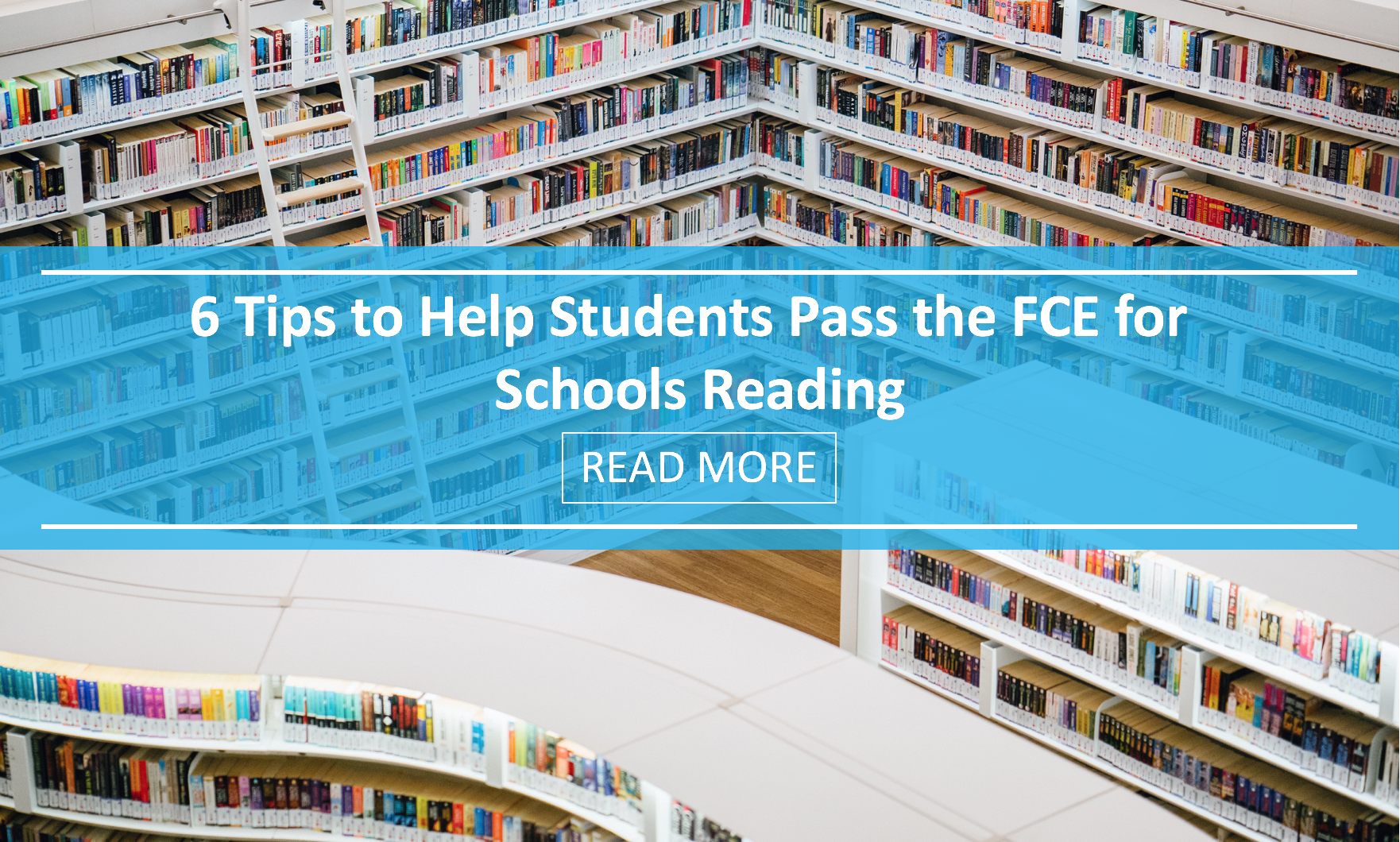6 Cool Ways to Help Learners in the FCE for Schools Listening


There is continued pressure for youngsters (some young as 13) to take these exams – the most common exam body has been Cambridge University for some time and its popularity and recognition remain high throughout the world.
In the past, it was more common for university students or post graduate students to sit English measuring exams and therefore the topics tended to be aimed at more ‘mature’ students who have had life experience, read more and have better general knowledge – things that younger students could not relate to. For years, younger students, although proficient in English have not been able to score well and have been let down by their general life experience, however, Cambridge University have now made it easier for all those younger students who struggled in the past to understand in-depth philosophic or science based texts due to their lack of experience, by creating a school (children) friendly exam with relatable topics. At first there was a lot of criticism surrounding Cambridge University’s bold move with critics quick to condemn the FCE exam for schools as a lower-version of the once esteemed exam yet what they don’t really understand well is that the levels itself have not changed – just the themes of the texts. Such changes have been welcomed by many; however, some teachers still don’t realize the changes in the exam despite it having been around since 2012. Additionally, other teachers treat the exam in the exact same way as the original exam without explaining the differences to students – leaving them unprepared and expecting differently resulting in lower grades yet again. Here a few useful tips for teachers to reacquaint themselves with the newly formatted exam more specifically the reading component.

The reading exam in the FCE for schools has three readings instead of four and the reading time has been cut down to a period of just 1 hour. Many teachers have their students practicing from the old exam papers which included 4 readings and with a time limit of 1 hour 30 minutes. Failing to tell students that the exam has changed for school students will affect them negatively, not because it’s more difficult (in fact it’s easier with less pressure) but because they were expecting something different and it throws them off kilter.
Teachers should offer their students the basic knowledge how to go about passing the reading section with good marks such as teaching them the valuable skills of skimming, scanning and identifying key words, however, ideally the students will have already learned them. Usually when students decide to sit the exams it’s about 4 months prior to the actual exam which gives them little time to achieve everything in terms of learning exam skills, the content of the exam and practicing past papers. In actual fact, if you’re a teacher who specializes in exam preparation, you should be teaching the students good exam and reading techniques from the very beginning of their English language course regardless of whether they’re sitting an exam at that time or not.
The problem with students and timing is that they do not get to practice under exam conditions therefore all previous efforts are wasted. Teachers should have students practicing under strict time limits from the beginning of the course in order for them to become accustomed to the limits. After they have read the text and answered the questions under a set time limit, they then can focus on the problem areas such as vocabulary, phrases and grammar.
The biggest mistake that teachers make when teaching FCE for schools is that they don’t introduce their students to a variety of texts that could appear in the exam and focus generally on short literature pieces, however, a number of different texts can be expected including: magazine and newspaper articles, fiction, reports, correspondence materials (e.g. emails, blogs) or informational materials (e.g. brochures, manuals, guides etc). If teachers really want to prepare their students as well as possible, they will introduce their learners to all different types of reading media in both exam and realistic form.
To make it more realistic, teachers can collect a number of ‘real’ texts e.g. email exchanges, travel brochures and what not and have students practice with them too. This motivates the students more as they are able to make a connection between what they are learning and the ‘real’ outside world. Younger students need more motivation to study and when they see connections they’ll start to see it as more worthwhile. However, do be sure to have the right kind of questions inserted to make the practice as ‘realistic’ as possible.
Additionally, as the FCE exam for schools is relatively new, there are very few practice exams and teachers have to ‘create’ their own materials sourcing different texts. Its all well and good giving students a variety of different texts, however, many teachers fail to comply with the word limits set by Cambridge which makes it unrealistic practice especially if they practice it as a timed exercise. A typical Cambridge for Schools FCE reading paper has approximately a total of 2,000 words and between 550-700 words per text – so if you do happen to choose your own materials try to have the word count as accurate as possible.
Younger students are not usually used to formal exams and most probably have written their past exams on the same paper as the questions, however, just like the regular FCE exam, there is a separate answer sheet and students are required to shade the right lozenges on the exam sheet. This, while it’s not really a big deal, does send younger students into a panic mode, which is why they should practice using the special answer sheet in the correct way (i.e. with pencil and capital letters). Because they have not had as much practice in formal exam situations like older students they will feel more pressure and it’s surprising how many silly mistakes are made just because the students are either feeling stressed or they are unprepared. A great way to introduce the answer sheet is to show the students collectively through a PowerPoint presentation catering for all learning styles and avoid any misunderstanding.
One of the biggest mistakes that teachers make is to not go over the answers. Usually there is limited time and a lot of pressure in correcting and going over why answers were right and wrong, however, it’s crucial in all kinds of exam preparation as it not only helps to pinpoint the weaker areas but it also helps students to boost their vocabulary and grammatical knowledge. Additionally, the more past papers you do with your learners, the more you’ll being to notice a pattern of repeated phrases, themes and grammatical phenomenon.
This section of the exam tests a lot of collocations and set phrases. Students often benefit from redoing the same reading papers 6-8 weeks later to see if they’re able to recall the previous mistakes.
Those teachers who train specifically for English based exams often forget to incorporate the communicative method and often due to time constraints cannot do so. However, in this section students are asked to infer meaning, a common reading exam trait, however, because of their age, they’re often unable to think in such a way. This can be helped through holding discussions about the text prior to and post reading with the teacher asking more direct questions so the students are able to learn to read between the lines and not just focus on the text itself.
Generally speaking, the most valuable thing you can do as a teacher is to help your students through collecting different materials catered at their age groups such as teen magazines and newspapers. This will not only make the reading time more interesting, it will also prepare them for the expected topics such as family, celebrities, school and friends. Additionally, use all text and course books to your advantage and make sure you cover every aspect of the book and not only focus on the text and questions. Make the most of all the pre-reading materials as it will allow students to activate their schematic knowledge and use their prediction skills – two things that are necessary when trying to infer.
Younger students are usually less motivated to learn for exams as there aren’t as many things riding on them unlike the general FCE exam, where older students may need it for a job or entry into a university or college, therefore they generally read less. Having your learners create a reading log of everything they’ve read over the week will motivate them more. Have them enter all the work they have read (whether it be a brochure, an online article, a blog post etc) and to write a one sentence description of it and their thoughts. It could be made into a competition or the students could be rewarded in some form when hitting their target.
They need to ensure that their learners are fully equipped for the exam as it’s more than likely this will be their first major exam outside of school. Encouraging them with interesting age-appropriate texts and focusing on discussion will also help students read more. Reading plays a huge part in any exam and reading is not only involved in the reading section, but it’s also involved in the questions in other sections – reading is an important skill and more focus needs to be given under the right exam conditions to ensure the students gain the marks they deserve and do not miss out on points due to the lack of preparation on the teacher’s behalf.